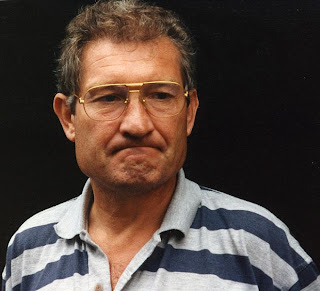 |
| Denis Menchov (image credit: Petit Brun CC BY-SA 2.0) |
Menchov won one stage and finished in 6th position at both the 2006 Tour and Critérium du Dauphiné, then concentrated on the Vuelta for 2007 where he won the Mountains and Combination classifications, a stage and the General Classification. He was back at the Tour in 2008 and managed 4th overall, having already finished 5th at the Giro d'Italia earlier in the year; then at the Giro the next year and won two stages and the overall General Classification, also coming second in the Points competition and third in the King of the Mountains - a considerable achievement. In 2010, his last year with Rabobank, he came 2nd in the Vuelta a Murcia and Tour di Romandie, then moved his Tour record up another notch by coming 3rd overall. For 2011, he went to Geox-TMC but didn't have such a good year, his only podium finish being 3rd at the Vuelta a Murcia. He rode the Vuelta a Espana again but this time came 5th, his team mate Juan José Cobo winning overall after a fabulous ascent of Alto de l'Angliru in which he made the infamously hard climb - the steepest in any Grand Tour - look easy.
At the end of the 2011 season sponsor Geox suddenly announced that it would be withdrawing from cycling immediately, leaving the team unable to continue. Menchov was fortunate enough to find a space with Katusha and enjoyed a good season with decent showings at the Vuelta a Andalucia and Volta a Cicilista Catalunya, victory at the National Individual Time Trial Championship, four top ten stage finishes (best: eighth, Prologue and Stage 8) followed by 11th place overall at the Tour de France and Stage 20 victory at the Vuelta a Espana. Katusha was denied a World Tour licence at the end of 2012, leaving it looking as though it would compete as a ProContinental team in 2013, but in February 2013 the Court for Arbitration in Sport ruled that the UCI had to grant it the licence. Menchov was, therefore, able to ride the Grand Tours and showed good form at the Volta ao Algarve in February when he finished in fourth place; however, when he suffered a knee injury during the Giro d'Italia, he retired from professional cycling.
On Menchov's birthday in 2013, the British Guardian newspaper published an article on Team Sky rider Chris Froome. In it, Menchov was incorrectly termed "a formidable climber and doper." In fact, he has never failed an anti-doping test and his 2005 Vuelta victory was awarded restrospectively following the disqualification of initial winner Roberto Heras; the newspaper later corrected its mistake.
| From The Guardian, 25.01.2013 |
 |
| Rene Pottier, 1879-1907 |
By all accounts, René Pottier was the finest climber of his day and was the fastest man up the 1,171m Ballon d'Alsace when he entered the Tour in 1905, beating Hippolyte Aucouturier, Louis Trousellier and Henri Cornet to the summit - the first time that a mountain had featured in the race. Despite his climbing ability, he lost his lead to Hippolyte Aucouturier after a puncture in his only remaining spare tyre caused by fans who had spread 125kg nails on the road - but fortunately for him, Aucouturier was a gentleman and generously handed over one of his own even though the puncture would have put his closest rival out of the race and so he was able to finish. The next day, he abandoned after a crash.
Pottier entered for a second time in 1906 and won five stages from the total thirteen. He led the race after Stage 1, having wrested it away from Emile Georget and was once again the first man up Ballon d'Alsace - but this year luck was on his side and he finished the stage a full 48 minutes ahead of the next rider. He remained race leader throughout the remainder of the event.
With the Tour won, he competed in the Bol d'Or 24 hour race at the famous Buffalo Stadium (so named because the first velodrome on the site had once hosted Buffalo Bill Cody's traveling Wild West Show) and completed 925.29km to win. However, life was to take an awful plunge for Pottier - some time early in the next year, he learned that while he'd been away winning the Tour his wife had been unfaithful to him. He entered a deep depression and, on this day in 1907, he hanged himself from the hook upon which he usually hung his bike at their home in Lavallois-Perret. He was 27.
There is a memorial to Pottier, erected by Henri Desgrange, at the top of the Ballon d'Alsace.
British mountain biker Dan Atherton was born today in 1982 near Salisbury. Originally interested in BMX, Atherton took up mountain biking when he was 16 and, by 2004, was National 4X Champion. He came 2nd in a round of the World Downhill Championship a year later before adding numerous good results over the next two seasons. In 2008, he became the World 4X Champion. Dan is the older brother of World Downhill Champions Gee (2010) and Rachel (2008).
Other cyclists born on this day: Brett Aitken (Australia, 1971); Luke Roberts (Australia, 1977); Elisabet "Elsbeth"van Rooy-Wink (Netherlands, 1973); Alan Danson (Great Britain, 1933); Sandra Temporelli (France, 1969); Alayna Burns (Australia , 1980); Harrie Jansen (Netherlands, 1947); Tomokazu Fujino (Japan, 1967).















